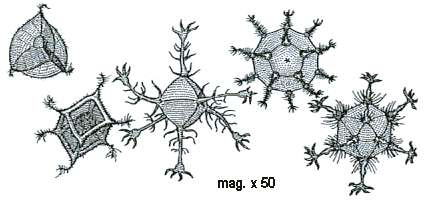Here’s an interesting error in the original version of “week241”:
I wrote:
Since pyrite is fundamentally a cubic crystal, the pyritohedron is basically made out of little cubic cells […]
It has 12 pentagonal faces, orthogonal to these vectors:
(0,1,2) (0,-1,-2)
(0,2,1) (0,-2,-1)
(1,0,2) (-1,0,-2)
(1,2,0) (-1,-2,0)
(2,0,1) (-2,0,-1)
(2,1,0) (-2,-1,0)
In fact the 12 vectors are these:
(2,1,0) (2,-1,0) (-2,1,0) (-2,-1,0)
(1,0,2) (-1,0,2) (1,0,-2) (-1,0,-2)
(0,2,1) (0,2,-1) (0,-2,1) (0,-2,-1)
I gradually realized my original guess made no sense, and then I confirmed this new guess by looking at this webpage recommended by CarlB:
mindat.org
If your webbrowswer can handle Java, go to this webpage and click on “Pyrite no. 7” to see a rotating pyritohedron. Then, while holding your left mouse button down when the cursor is over the picture of
the pyritohedron, type “m” to see the vectors listed above. They’re called “Miller indices”.
If you think of these 12 vectors as points in space, they’re the corners of three 2×1 rectangles: a rectangle in the xy plane, a rectangle in the xz plane, and a vector in the yz plane.
These points are also corners of an icosahedron! It’s not a regular icosahedron, though. It’s probably the “pseudoicosahedron” shown here:
Building isometric crystals with unit cells
To get the corners of a regular icosahedron, we need to replace the
number 2 by the golden ratio Φ:
(Φ,1,0) (Φ,-1,0) (-Φ,1,0) (-Φ,-1,0)
(1,0,Φ) (-1,0,Φ) (1,0,-Φ) (-1,0,-Φ)
(0,Φ,1) (0,Φ,-1) (0,-Φ,1) (0,-Φ,-1)
The number 2 thus deserves to be called the “fool’s golden ratio”.
Just as the regular docahedron is dual to the regular icosahedron - the vertices of the regular icosahedron give the normal vectors to the faces of the regular dodecahedron - I bet the pyritohedron is dual to the pseudoicosahedron.
So, we could call the pyritohedron the “fool’s dodecahedron”, and the pseudoicosahedron the “fool’s icosahedron”. Fool’s gold may
have fooled the Greeks into inventing the regular dodecahedron, by giving them an example of a fool’s dodecahedron!
As pointed out by Noam Elkies and James Dolan, there is a sequence of wiser and wiser dodecahedra whose faces have normal vectors
(B,A,0) (B,-A,0) (-B,A,0) (-B,-A,0)
(A,0,B) (-A,0,B) (A,0,-B) (-A,0,-B)
(0,B,A) (0,B,-A) (0,-B,A) (0,-B,-A)
where A and B are the nth and (n+1)st Fibonacci numbers, respectively.
As n → ∞, these dodecahedra approach the regular dodecahedron in shape, because the ratio of successive Fibonacci numbers approaches the golden ratio.
When A = 1 and B = 2, we get the fool’s dodecahedron, since only a fool would think 2/1 is the golden ratio.
However, this is not the most foolish of all dodecahedra! The case A = 1 and B = 1 gives the rhombic dodecahedron, which doesn’t even have pentagonal faces:

So, the rhombic dodecahedron deserves to be called the “moron’s dodecahedron” - at least for people who think it’s actually a regular dodecahedron.
But actually, even this dodecahedron isn’t the dumbest. The Fibonacci numbers start with 0:
0, 1, 1, 2, 3, 5, 8, 13, 21, 34, …
So, even more foolish is the case A = 0 and B = 1. Here our 12 vectors reduce to just 6 different ones:
(1,0,0) (1,0,0) (-1,0,0) (-1,-0,0)
(0,0,1) (-0,0,1) (0,0,-1) (-0,0,-1)
(0,1,0) (0,1,-0) (0,-1,0) (0,-1,-0)
These are normal to the faces of a cube. So, the cube deserves to be called the “half-wit’s dodecahedron”: it doesn’t even have 12 faces, just 6.
Some pyrite crystals are cubes. Half-wit Greeks mistook these for regular dodecahedra.
Moving in the direction of increasing wisdom, we can consider the case A = 2, B = 3. This gives a dodecahedron which is closer to regular than the pyritohedron. And, apparently it exists in nature! It shows up in this list of crystals:
Projections of cubic crystals
They also call this one a pyritohedron, so presumably some pyrite forms these less foolish crystals! You can compare it with the A = 1, B = 2 case here:
A = 1, B = 2 pyritohedron
A = 2, B = 3 pyritohedron
It’s noticeably better!


 ,
, .
.

 .
. .
. .
.



Re: This Week’s Finds in Mathematical Physics (Week 241)
On a tangential note, reading what you say about singularities, in what ways might we expect theories concerning them - resolution, quivers, MacKay correspondence, etc. - to have something to say about the singularities which appear in monoidal n-categories with duals? You showed us the swallowtail catastrophe here, and I seem to recall in Carter and Saito’s work, which you used in your paper on 2-tangles, seeing other ones. Oh yes, there’s the swallowtail on p. 67 of their paper with Kauffman, Diagrammatics, Singularities, and Their Algebraic Interpretations, followed by many others.